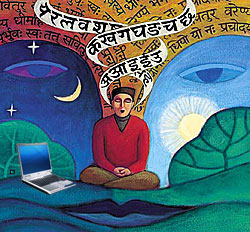The Great Village in the Sky: Promise and Perils of Altruism on the Internet
One of the most striking aspects of people’s treatment of each other online is how starkly it runs counter to early visions of what the Internet could have done to interpersonal culture.
 This article was originally published on Science 20, and was written by Jamil Zaki.
This article was originally published on Science 20, and was written by Jamil Zaki.
A few years ago, the artist Wafaa Bilal decided to see how many people, given the chance, would shoot him. He rigged a paintball gun and web camera so that people could log on to his website, chat with him online, and—if they wished to—aim and fire at Bilal from anywhere in the world. He then shut himself and the whirring, rotating gun in a room for 30 days. Over the course of the month, people from around the world began shooting, and then kept on shooting, with increasing enthusiasm as time went on. By the experiment’s end, Bilal had been shot at 60,000 times.
Bilal’s project held heavy political overtones—the artist is from Iraq, and wanted to recreate the sense of bombardment felt by his family members there—but it also brings into stark relief a strange quality of the Internet: its users’ constant readiness to electronically pounce on anyone available. People’s willingness to malign each other online is notorious enough to have generated its own theorem: Godwin’s Law states that as the length of a website’s comment thread increases, “the probability of a comparison involving Nazis or Hitler approaches 1.” The unfriendly side of the interpersonal Internet, however, goes far beyond repeated reductio ad hitlerum accompanying Youtube posts. People often treat each other with shocking cruelty and indifference online, including an explosion of “cyber-bullying,” the use of the internet to stage elaborate, sometimes anonymous attacks on others that often result in deep psychological damage and even suicide. Cyberbullying has become problematic enough that last year, the House of Representatives considered a bill that would make online harassment punishable by prison sentences.
One of the most striking aspects of people’s treatment of each other online is how starkly it runs counter to early visions of what the Internet could have done to interpersonal culture. Marshall McLuhan, who originally coined the term “Global Village,” was nothing if not hopeful about the power of technology to bring people together. He claimed that digital media would “extend our central nervous system,” allowing us to directly share experiences with people all over the world. On McLuhan’s view, this sharing would prompt a heightened awareness of our responsibility for each other’s well being. McLuhan was not alone in arguing for the potential of media to bind our emotions to those of others. For example, Susan Sontag catalogued the many ways that images of suffering—from Vietnam to Abu Ghraib—increase the fervor with which witnesses oppose further suffering. Now that such content can be generated and broadcast by almost anyone on Earth (think of cell phone videos uploaded from Hurricane Katrina or the recent Iranian protests) our ability to connect with others should be at an all time high. In essence, the Internet should work as a cross-continental empathy amplifier.
Why, then, do people fail to act as though they’re part of a village, and instead treat the Internet like a Global Cagematch? Some possible explanations emerge from research exploring the psychological and neural roots of altruism: helping others at no benefit, and often at a cost, to the helper. This work has highlighted some rosy features of human behavior: altruism exists across cultures and very early in life, suggesting that it comes naturally, as opposed to being learned.
Psychologists have examined two major factors driving altruism that may be especially susceptible to breaking down on the Internet. The first is the emotional, and potentially visceral, sense of connectedness we feel towards others. There is impressive evidence that when watching others experiencing emotional states, such as pain, disgust, and pleasure, observers’ brains do something curious: they display the same patterns of activity as they would if observers experienced those states themselves. This neural resonance matches insights of philosophers since Adam Smith, who believed that moral sensibility was built on the human tendency to “bring home,” or directly live other people’s experiences. Neural resonance makes us wince when we see a friend stub her toe, yawn when a co-worker does, and generally feel linked to one another.
However, neural resonance has important boundary conditions, and can partially shut down when observers feel as though someone is untrustworthy or dissimilar to them politically or ethnically. These same cultural splits can dissolve people’s interest in helping each other as well. For example, experimenters recently took advantage of the passion that is UK soccer fandom to test the effects of dissimilarity on helping. They created a situation where Liverpool fans—who have a decades long rivalry with Manchester United—encountered a person who had just injured themselves while running. Some of these people saw a runner wearing a Liverpool jersey, while others saw a runner wearing a Manchester jersey. Overwhelmingly, participants helped their fellow fans, and walked right by injured rivals. This type of tribalism was probably at work in a recent study of Red Sox and Yankees fans who demonstrated neural signs of reward processing when watching their teams trounce each other, but not when their team beat the (presumably more neutral) Orioles.
Tuning out the emotions of rivals could make sense evolutionarily: in times of scarce resources and potential competition, going to bat for people from other groups may have proved maladaptive. Yet the crux of what McLuhan and others thought new media could do is recast the meaning of “group” to span the entire world. Instead, people often use the internet to draw battle lines between opposing points of view on everything from the President’s birthplace to the relative virtues of PCs and Macs, cement their identification with one camp, and argue with surprising vitriol against people who disagree with them. Instead of being an empathy amplifier, the Internet in these cases has served as a venue for people to try on less tolerant identities, and practice dehumanizing others, a trend so dominant that one blogger recently described it as a potential new illness: InternetAsperger’s Sydrome.
The bile of Internet debate also hinges on the dissolution of another foundation of altruistic behavior: reputation. One of the central qualities of villages—and any other community similar to those we inhabited for the vast majority of human history—is that everyone knows everyone. As such, taking advantage of others for one’s personal gain actually doesn’t provide that much personal gain at all: such behavior ignites a slew of emotions that motivate communities to punish and ostracize cheaters (for a great example of anti-cheater passion, see Elie Wiesel’s statement on Bernie Madoff). Theoretical and mathematical models have demonstrated that punishment and reputation protect altruistic societies from Ponzi schemes and other forms of antisocial behavior, by not letting anyone forget their interdependence with the rest of the group. The Internet famously obliterates this principle, by allowing users almost complete anonymity. This renders the Web simultaneously a vital, global experiment in freedom of expression, and a reversal of the social environments we evolved to inhabit.
Is there any way to apply the principles of altruism research to making the Internet a kinder, more Village-like place? At least some options come to mind. First, there are ways to increase the likelihood that media—and online—representations of other people’s emotions will stir resonance in observers (some of which I’ve discussed in another article). For example, nuanced, first person narrative accounts of people’s experience encourage readers to take the perspective of people far different from themselves, a psychological exercise that can ramp up neural resonance and altruistic helping. The Internet is ideally suited to disseminating such accounts in an unfiltered way, and several online news sources, such as the Common Language Project and Mideast Youth focus on just this type of narrative journalism. Another way to emphasize commonality between people not specific to the Internet is to emphasize facts and issues that make salient our connection to and interdependence with one another, such as a common threat or goal. Recently, the international economic collapse and the equal opportunity threat of climate change have provided excellent material for recognizing how tightly knit our collective central nervous system really is.
Creating a sense of reputation on the Internet is a much thornier issue, as the only ways to do so involve slippery limitations of free speech. Nonetheless, recent cases have prompted the question of whether the rights to anonymity may have limits. This summer, for example, a court ordered Googleto release the name of an anonymous blogger who had defamed a local model, prompting a New York Times columnist to praise the decision as confirming that in any public forum, “transparency should be the default mode.” After cyberbullying led to an actress’ suicide in South Korea, that country’s government took an even stronger stance, by proposing an (unpopular) law forcing any commenter on a large website to identify themselves using their name and national ID number. Forcing people to own up to their behavior could certainly take the bite out of some people’s online bark by (and one can imagine that such measures could have drastically shifted the outcome of Bilal’s paintball experiment).
Integrating knowledge about science to improving community on the Internet—or, for that matter, attempting to systematically affect the messy, relentlessly democratic human tangle that is the Web in any way—is anything but straightforward. Obviously, there are cases in which anonymity is critical: for example, the recent use of Twitter to organize protests in Iran could have held grave consequences for organizers had they been publicly identified. Similarly, structuring media to maximize neural and interpersonal resonance can seem like a risk to impartiality (even using the term “empathic” as a judicial qualification can cause a bewildering backlash). However, to whatever extent policy makers and users wish to use any top-down regulation in an effort to help maximize the Internet’s cultural potential, they would do well to take into account scientific clues about how to make this Village more like any other.
Credits CC FlickR by Colin Purrington, WilliamsProjects, chucks and Kevin Steele.




Laisser un commentaire